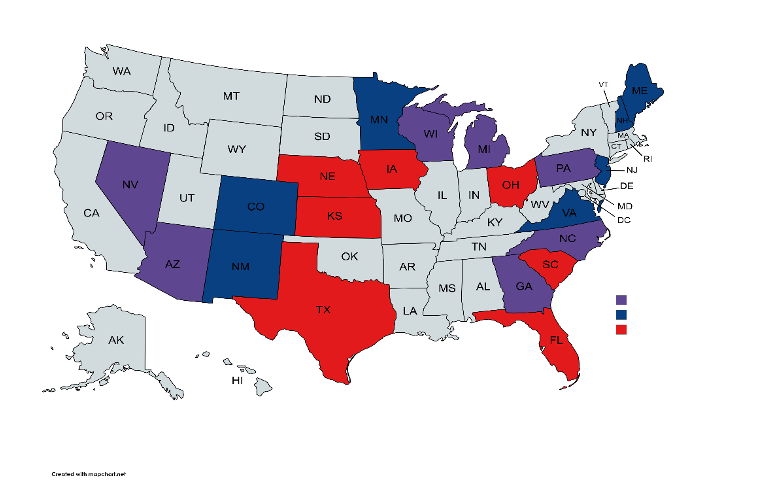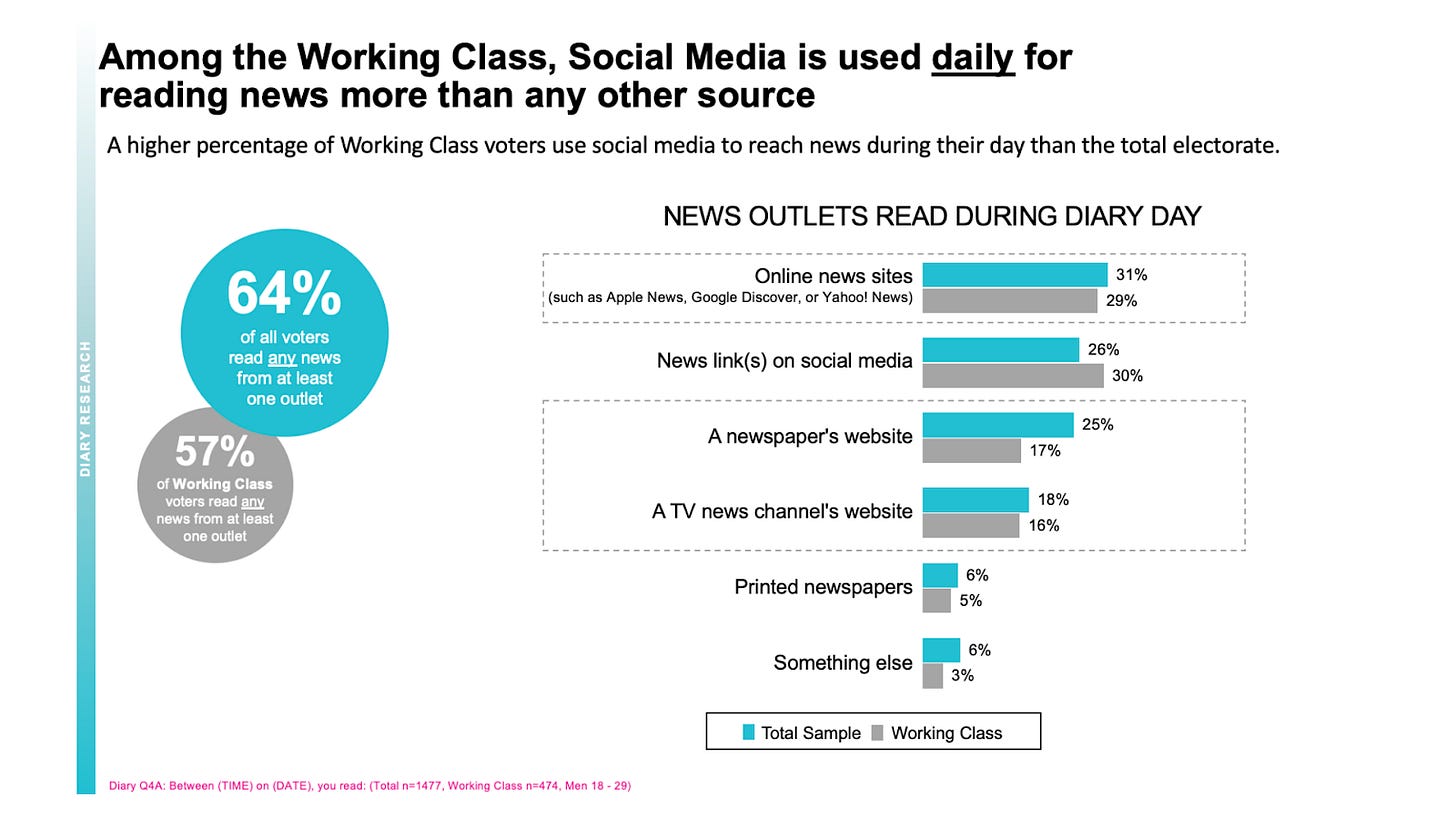Deep Dive: Where Working Class Voters Get Information, and How and When to Reach Them
In a massive survey of thousands of voters, we wanted to learn more about how voters consume information, and what sources of information working class voters utilize more than the general public.
We’re back this week with another update from the largest research effort to understand why working class voters are trending away from Democrats.
This week, we are doing our first deep dive into the results of a massive, 7500+ person survey of media consumption habits among the U.S. electorate. This was a fascinating look at how registered voters across our 21 focus states are getting their information, the platforms and services they use, and who they trust for getting news or other information.
The survey included more than 2,000 working class voters.
At the end of the survey, respondents were invited to participate in a more in-depth 24-hour media usage diary, and nearly 500 working class voters took part.
The diaries were filled out each hour, allowing both overall daily and more detailed time spent by part-of-day with different types of media.
It’s important to note that this survey and diary sought to understand their overall media consumption – not just news. We wanted to learn more about the entertainment streaming services they use, the social media platforms they spend the most time on, and whether they listen to music or podcasts more, among other things.
This survey was intended to gain a deeper understanding of the information ecosystems voters live in, in order to gain insights into how to reach voters where they are and what platforms and venues are most important. The information we’ve gleaned from the media consumption analysis dovetails with what we’ve heard about media usage and trends in our focus groups so far. We’ll share more findings from this survey next week, specifically on the platforms working class voters are using and what news sources they trust most.
INITIAL TOPLINE TAKEAWAYS
Working class voters are more likely to consume news via links on social media than the general population. Overall, they use YouTube and social media more than the general population (including more regular TikTok consumption), and only 1 in 20 ever read a print newspaper.
Early morning is prime time for news consumption among working class voters. News readership spikes between 6:00 and 7:00 AM, and most working class voters (3 of 5) proactively read a news article at some point each day.
Audio is a critical format for working class voters. From early morning to early evening, working class voters say they use audio throughout the work day, including streaming services like Spotify or Pandora as well as traditional AM/FM radio, more than the general population.
HOW DO WORKING CLASS VOTERS GET INFORMATION?
Like most other voters, working class voters consume a lot of TV or online video content. But when it comes to other platforms, working class voters’ habits stand out.
For example, working class voters are more likely than the general population to use social media, listen to audio, use YouTube, and play video games. They are less likely to read news.
This illustrates the complexity of reaching working class voters with news or political content – and makes clear that social media algorithms may play a larger role in how working class voters get information versus other voter groups.
There is some age variance in how working class voters get their news. Voters over 50 still overwhelmingly get news and information from TV. But the social media trend seen above is huge among voters under 50 – with 62% of those aged 18-49 saying they use social media and YouTube most for news.
Working class voters also don’t really consume news throughout the day or in the evening. Their peak news consumption is first thing in the morning, likely before they go to work. Later in the day, they are more likely to be exposed to audio (streaming and radio, likely while they work), as well as nighttime entertainment media consumption like TV, streaming, and video games.
For years, the political media ecosystem has centered on cable news, the nightly news, and primetime programming, but these findings show that approach is fundamentally out of touch with how working class voters consume media.
Sure, they may see aggregated content of traditional news on social media, YouTube, or in their morning news-reading. But overall, reaching these voters that have drifted away from the Democratic Party requires understanding that they are less likely to be exposed to traditional news content in their daily media consumption.
AUDIO REMAINS A KEY WAY TO REACH WORKING CLASS VOTERS
Working class voters are more likely to listen to audio throughout the work day than the overall population. (More than 4 in 5 working class voters told us they listen to audio at some point during the day.) This may seem obvious on its face – working class voters may be more likely to commute to work, have workplace settings where they have a radio on, or have opportunities where they can put their headphones in and listen to streaming music or audio while they work.
Interestingly, as you can see in the chart below, working class voters name traditional over-the-air AM/FM radio as a more frequent news source than newspapers, Instagram, TikTok, X, or podcasts.
NEXT UP: FACEBOOK, YOUTUBE, TIKTOK, AND OTHER PLATFORMS – PLUS: WHO WORKING CLASS VOTERS TRUST
We are going to continue to unpack this mammoth survey for you next week, when we’ll have a deeper dive on the social media platforms working class voters are using, how they’re using them, and what sources of news and information working class voters trust the most.
As we provide these findings, let us know if you have thoughts or want to know more by leaving a comment.












Excellent overview! The audio numbers seem dead-on. I'd also add satellite radio operator Sirius XM: 25.6 mil subscribers, 3mil sq. miles of coverage (coast-to-coast), as well as 200 miles off-shore. We can get to them somehow. Thanks for all your efforts!
Please, please, please, provide your methodology information for transparency. Exactly how many people are you reporting on for each study (or report)?? How are you defining 'working class'? What are your field dates, etc.?